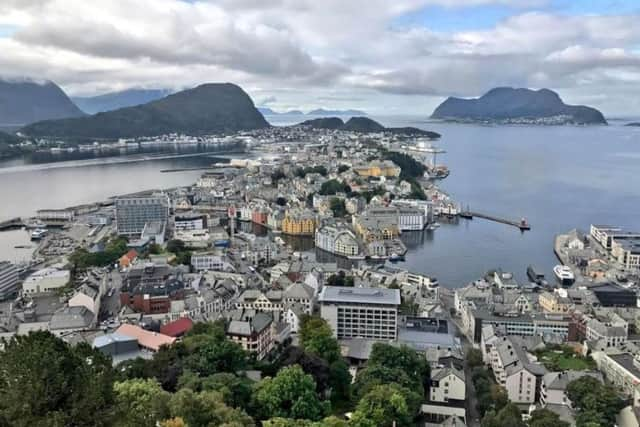Video: Britain's best chippies bring supply chain full circle in Norway
Peterhead port and fish market is the central hub of Scotland’s fishing industry.
Just over £100 million of white fish was sold through the market last year. Almost all of the haddock is consumed here in Scotland, while the cod is shipped down to England and beyond.
Advertisement
Hide AdAdvertisement
Hide AdAs you travel south, cod gradually replaces haddock on the menus of Britain’s 11,000 chip shops.


We annually tuck into some 382 million fish and chip suppers and to feed that hunger you need a lot more cod than Scottish skippers land in a good year.
Peterhead is twinned with the Norwegian fishing town of Ålesund, a coastal settlement able to trace its fishing heritage back thousands of years. Today it’s one of many ports used to land cod and other white fish bound for British chippies.
The UK consumes 238,700 tonnes of cod every year and 21 per cent of that is sourced from Norwegian waters. Of the 130,400 tonnes of haddock we enjoy, 31 per cent is Norwegian.
From 11,000 chip shops down to a handful of the very best in Britain, ten finalists in The National Fish and Chip Awards went on a fact-finding mission to Ålesund to visit the source of their fish. They witnessed the benefits of MSC accreditation first-hand and discovered the lengths the Norwegian Seafood Council have gone to nurture sustainable fish stocks in the Barents Sea with environmentally conscious efficiency.


Aboard the colossal 800-tonne, 51 meter-long Geir II fishing vessel, they watched as ethical longlines real in fresh Norwegian cod. The entire process from hook to the frozen-at-sea freezers was minutes. An onboard factory manned by the crew guts, debones, descales, fillets and deep freezes the fish aboard the Geir II with startling precision.
‘Frozen-at-sea’ fish are cooled quicker than they can begin decomposing, guaranteeing their freshness on long voyages before the Geir II crew turn around for port.
Advertisement
Hide AdAdvertisement
Hide AdTransparence and sustainability have worked wonders for Norway’s coastlines - all cod and haddock stocks in the Barents Sea are MSC-accredited and supply the Scandinavian nation with one of the largest growing and sustainably managed stocks in the world.


The Scottish National Fish and Chip Awards regional winner, Wendy Frame, runs Cromar’s Fish and Chips in St Andrews. Sourcing fish from Peterhead makes too much sense for Cromar’s, but she was delighted to have been given an international perspective of the industry outside Scotland.
“This trip has been fantastic,” she said, “Just getting the opportunity to be here and meet the other nine finalists in the National Fish and Chip Awards has been amazing.
“It’s been great being around so many like-minded people - we all think a certain way and we all have passion for the same industry.
Winning the 2018 National Fish and Chip Awards was Millers Fish and Chips from York. In Ålesund representing his family’s shop was Nick Miller, justly rewarded for his modern approach to customer outreach and brand identity. Most of Nick’s fish comes from Norway, and much of it is likely landed on the docks down below.


At the top of the observatory, overlooking Ålesund and out to the Norwegian sea, he said: “For us it’s amazing because we get to come over here and find out exactly where the fish comes from.
To meet families that are like-minded to us - who care about he quality and not just about catching fish and making money.
“It’s really important and we found that common ground.”
On their final night, the finalists enjoyed an authentic Norwegian five-course dinner, rubbing shoulders with titans of Nordic fishing industry. They ate alongside members of Seafish, the Seafood from Norway and the Norwegian Seafood Council, Marine Stewardship Council, the crew of the Geir II and an extended room full of skippers and crewmen.
Advertisement
Hide AdAdvertisement
Hide AdFor the celebrated fryers, it was an unforgettable voyage of gastronomical discovery, renewing their interest in the international fishing community, forging new friendships and strengthening old partnerships from across the North Sea.